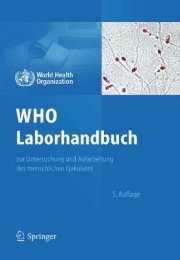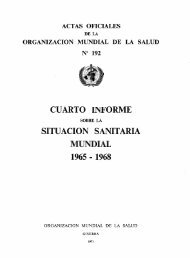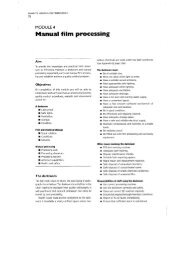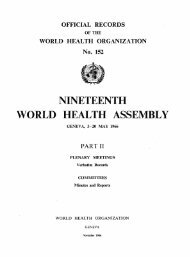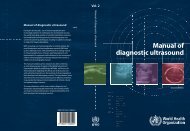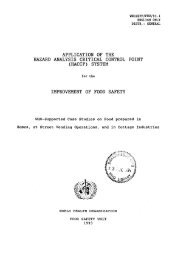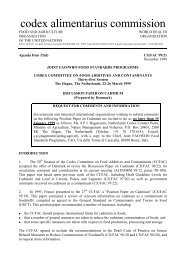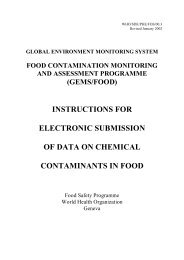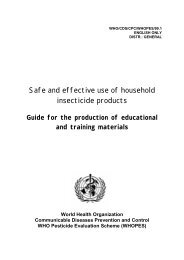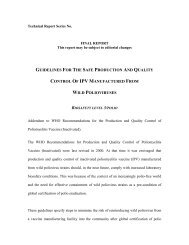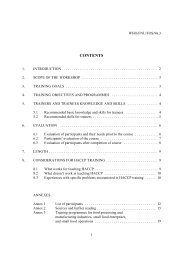WHO Drug Information Vol. 20, No. 4, 2006 - World Health ...
WHO Drug Information Vol. 20, No. 4, 2006 - World Health ...
WHO Drug Information Vol. 20, No. 4, 2006 - World Health ...
You also want an ePaper? Increase the reach of your titles
YUMPU automatically turns print PDFs into web optimized ePapers that Google loves.
Safety and Efficacy Issues<br />
ADRAC advises that prescribers avoid<br />
the triple whammy wherever possible.<br />
However, if these drugs are necessary,<br />
prescribers should be alert for situations<br />
such as illness, dehydration or initiation of<br />
an NSAID, which may predispose patients<br />
on this combination to renal failure,<br />
and advise patients to seek medical<br />
advice during such episodes.<br />
Extracted from Australian Adverse <strong>Drug</strong><br />
Reactions Bulletin, <strong>Vol</strong>ume 25, Number 5,<br />
October <strong>20</strong>06.<br />
References<br />
1. ADRAC, Thomas M. Diuretics, ACE inhibitors<br />
and NSAIDs - the triple whammy. MJA<br />
<strong>20</strong>00; 172: 184-5.<br />
2. Boyd IW, Mathew TH, Thomas MC. COX-2<br />
inhibitors and renal failure: the triple whammy<br />
revisited. MJA <strong>20</strong>00; 173: 274 (corr. MJA<br />
<strong>20</strong>00; 173: 504).<br />
3. ADRAC. ACE inhibitor, diuretic and NSAID:<br />
a dangerous combination. Aust Adv <strong>Drug</strong><br />
React Bull <strong>20</strong>03; 22: 14-15.<br />
Colchicine: safe use is critical<br />
New Zealand — Colchicine in overdose<br />
is extremely toxic and has resulted in<br />
fatalities. Prescribers are reminded that<br />
colchicine is now indicated as second-line<br />
therapy in the treatment of acute gout,<br />
after nonsteroidal anti-inflammatory<br />
drugs. Corticosteroids are recommended<br />
where both are contraindicated (1).<br />
Due to the risk of dose-related serious<br />
adverse effects, the use of high doses of<br />
colchicine to treat acute gout is no longer<br />
appropriate, especially in elderly patients,<br />
patients with impaired hepatic or renal<br />
function, and patients who weigh less<br />
than 50 kg. The dosing interval for colchicine<br />
has been increased from 2–3 hourly<br />
to six hourly. For otherwise healthy adults<br />
the maximum dose of colchicine in the<br />
first 24 hours is 2.5 mg and the total dose<br />
given in an acute attack should not<br />
exceed 6 mg over four days. Further-<br />
252<br />
<strong>WHO</strong> <strong>Drug</strong> <strong>Information</strong> <strong>Vol</strong> <strong>20</strong>, <strong>No</strong>. 4, <strong>20</strong>06<br />
more, it is no longer considered safe or<br />
appropriate to continue dosing until<br />
gastrointestinal adverse effects occur (1).<br />
Patients should be warned of the symptoms<br />
of colchicine toxicity and advised to<br />
immediately discontinue therapy and see<br />
their doctor if symptoms occur.<br />
Extracted from Prescriber Update, <strong>Vol</strong>ume 27,<br />
Number 1, June <strong>20</strong>06. at: http://www.medsafe.<br />
govt.nz/pProfs/PUarticles.htm<br />
Reference<br />
1. Medsafe Pharmacovigilance Team. Colchicine:<br />
Lower doses for greater safety. Prescriber<br />
Update <strong>20</strong>05;26(2):26-27. http://<br />
www.medsafe.govt.nz/profs/PUArticles<br />
colchdose. htm<br />
Nitrofurantoin: monitor lung<br />
function in long-term use<br />
New Zealand — An earlier article in<br />
Prescriber Update reported a case of fatal<br />
interstitial lung disease resulting from<br />
long-term nitrofurantoin therapy (1). The<br />
Centre for Adverse Reactions Monitoring<br />
continues to receive reports of acute and<br />
chronic pulmonary adverse reactions<br />
associated with nitrofurantoin. Acute<br />
pulmonary reactions typically have<br />
hypersensitivity-type features and occur<br />
1–2 weeks after initiation of nitrofurantoin.<br />
Chronic pulmonary reactions mainly<br />
involve older persons, are often insidious<br />
in onset and associated with therapy of<br />
six months or longer. Interstitial lung<br />
disease and pulmonary fibrosis may<br />
develop so it is important to avoid any<br />
delay in the recognition of nitrofurantoininduced<br />
lung changes.<br />
The pulmonary function of patients<br />
undergoing prolonged nitrofurantoin<br />
therapy should be monitored. This involves<br />
careful vigilance for early features<br />
of emerging pulmonary toxicity which may<br />
be evidenced by cough or shortness of<br />
breath, indicating the need for prompt



